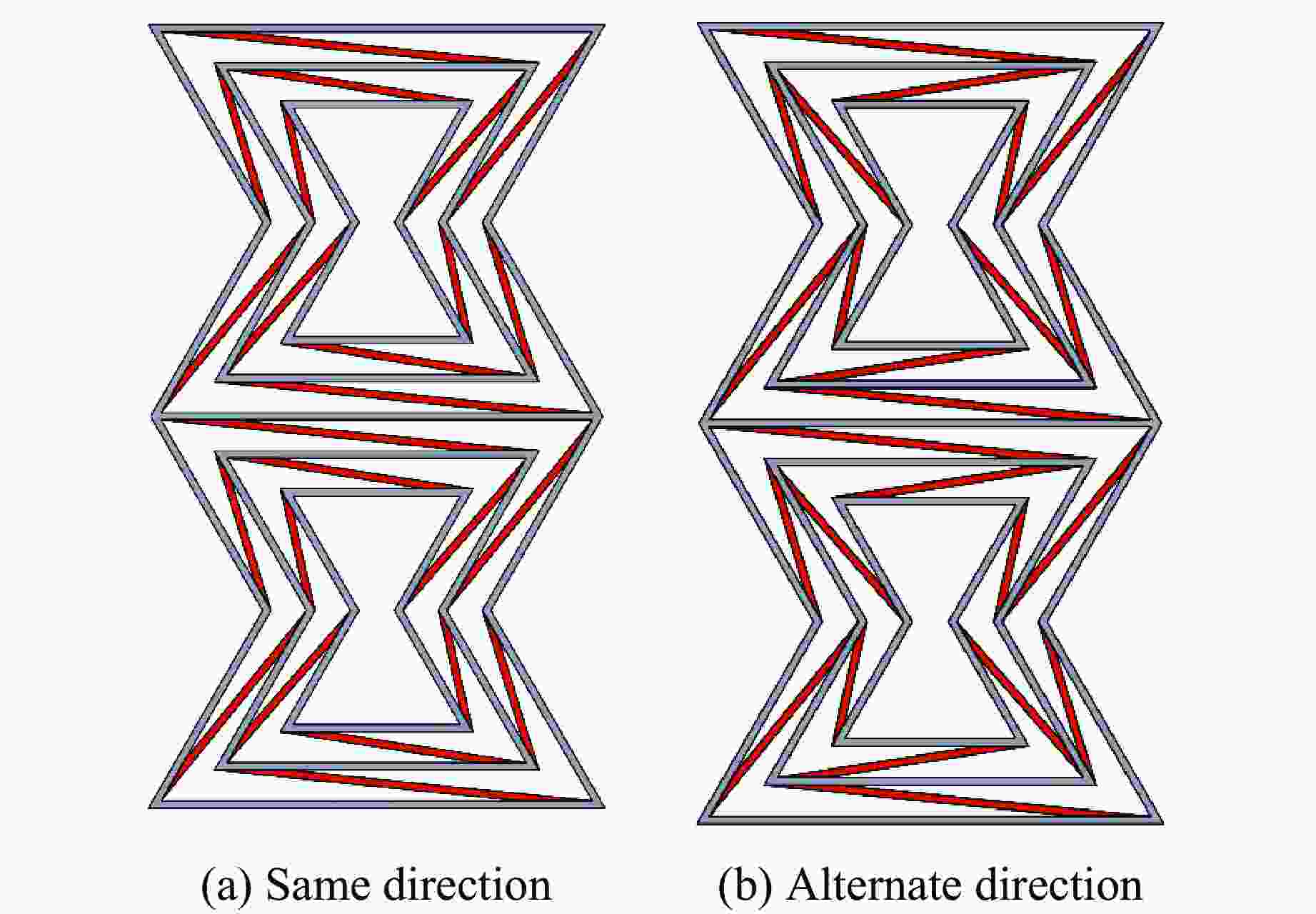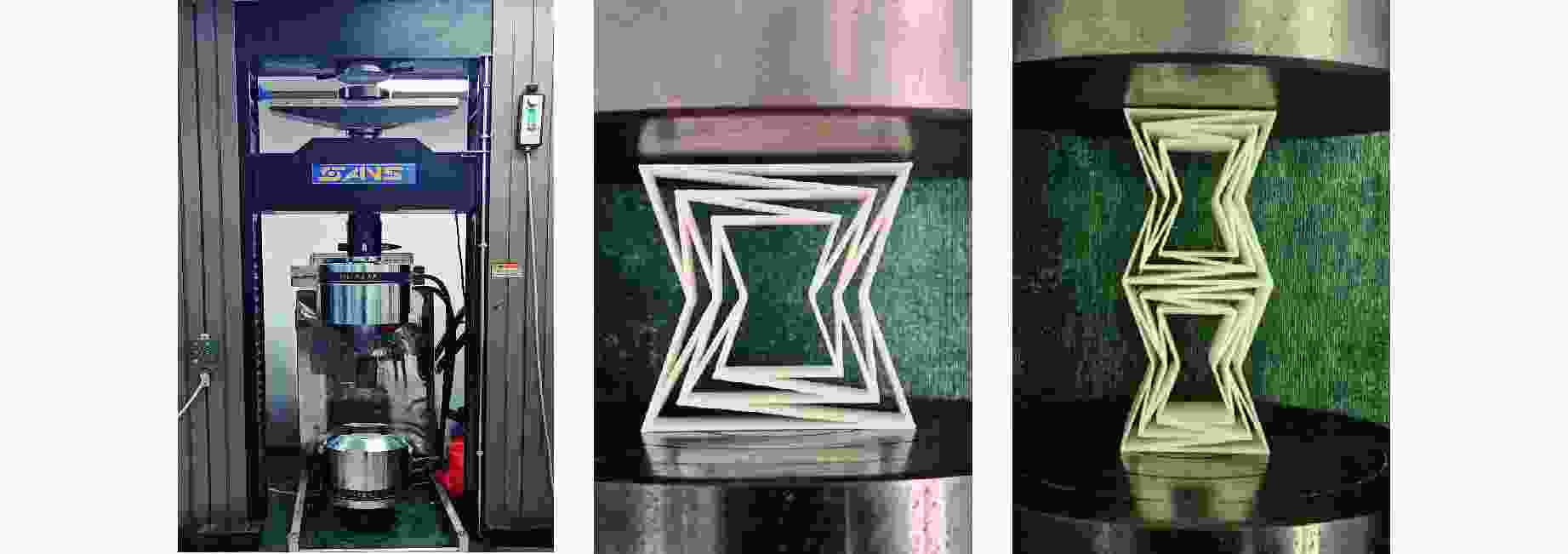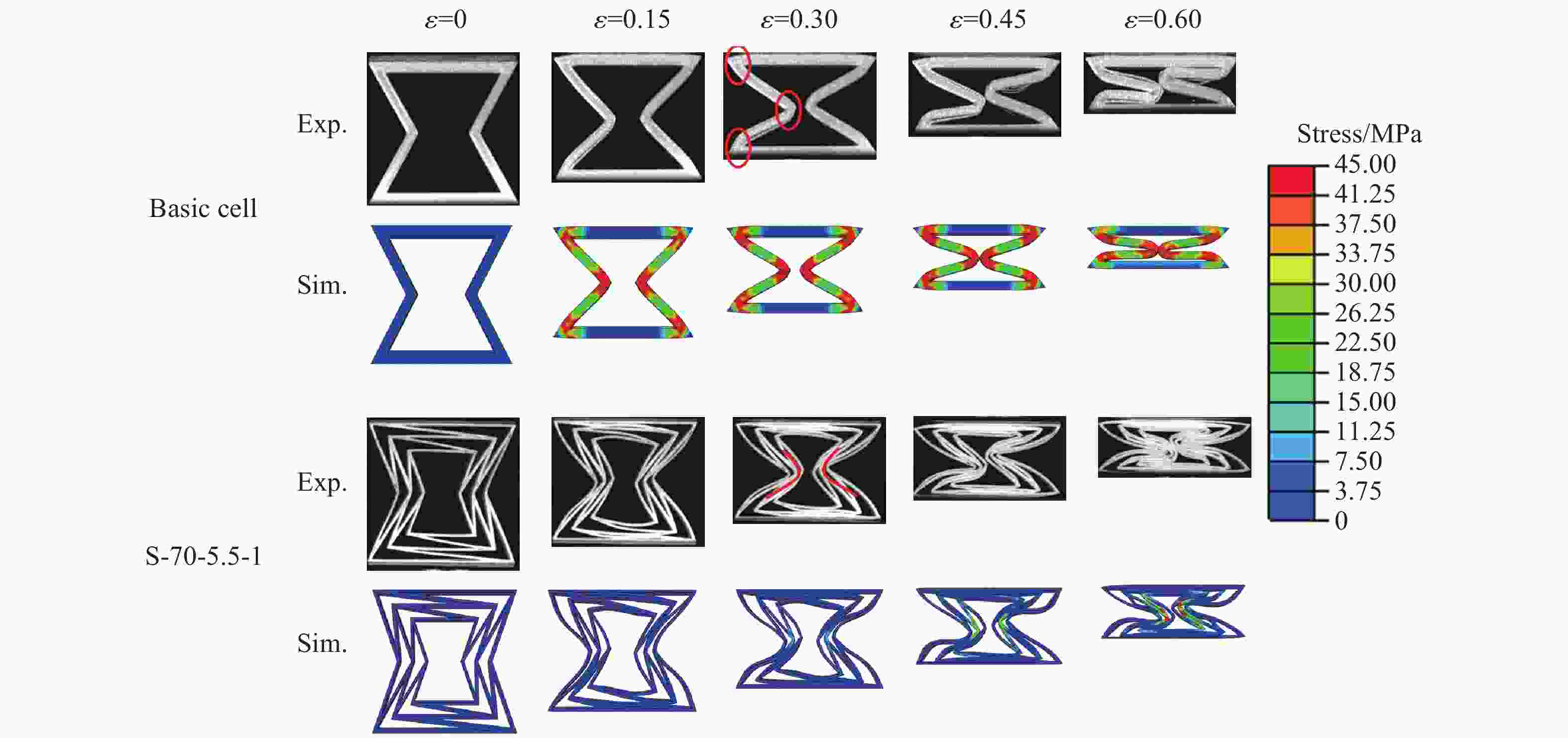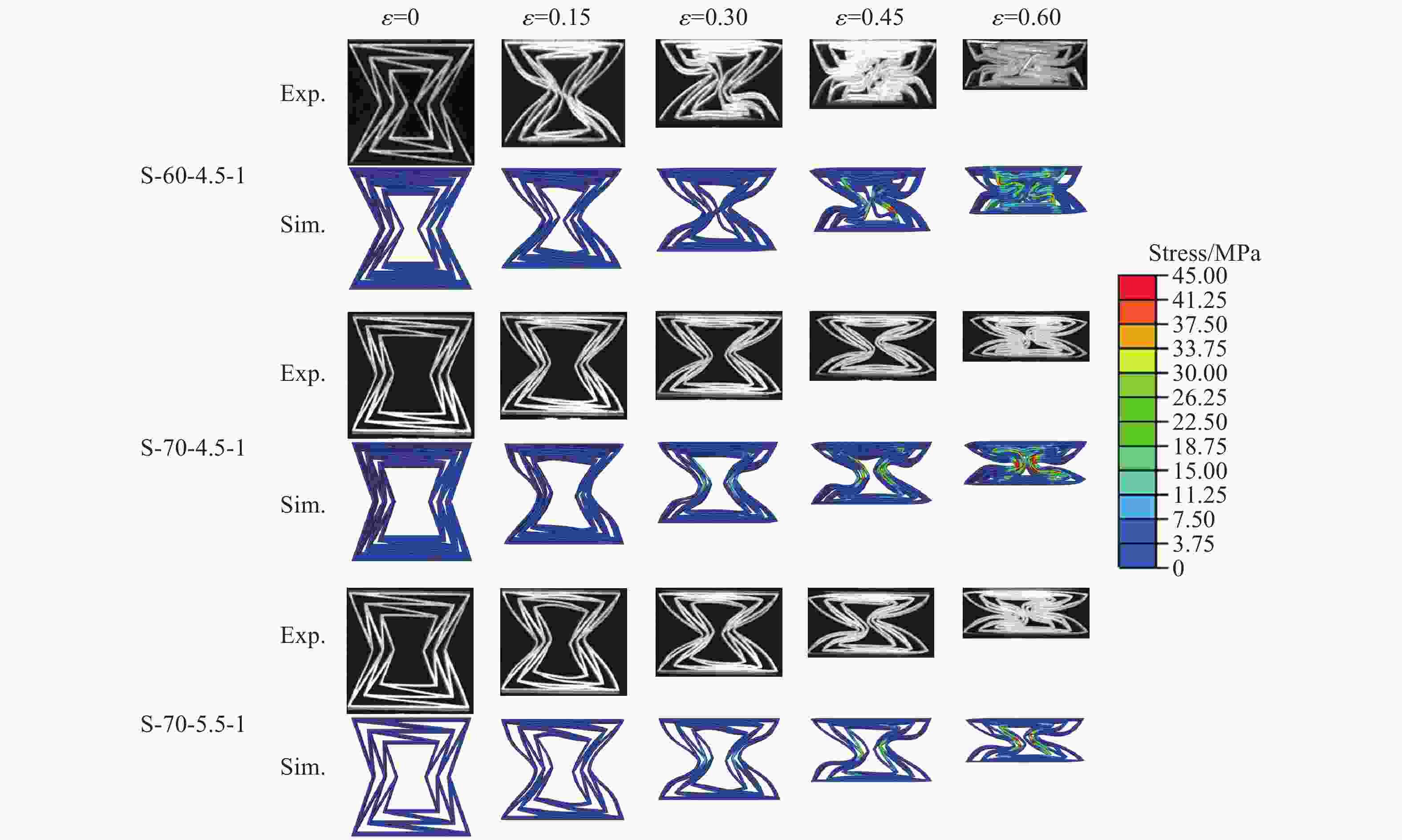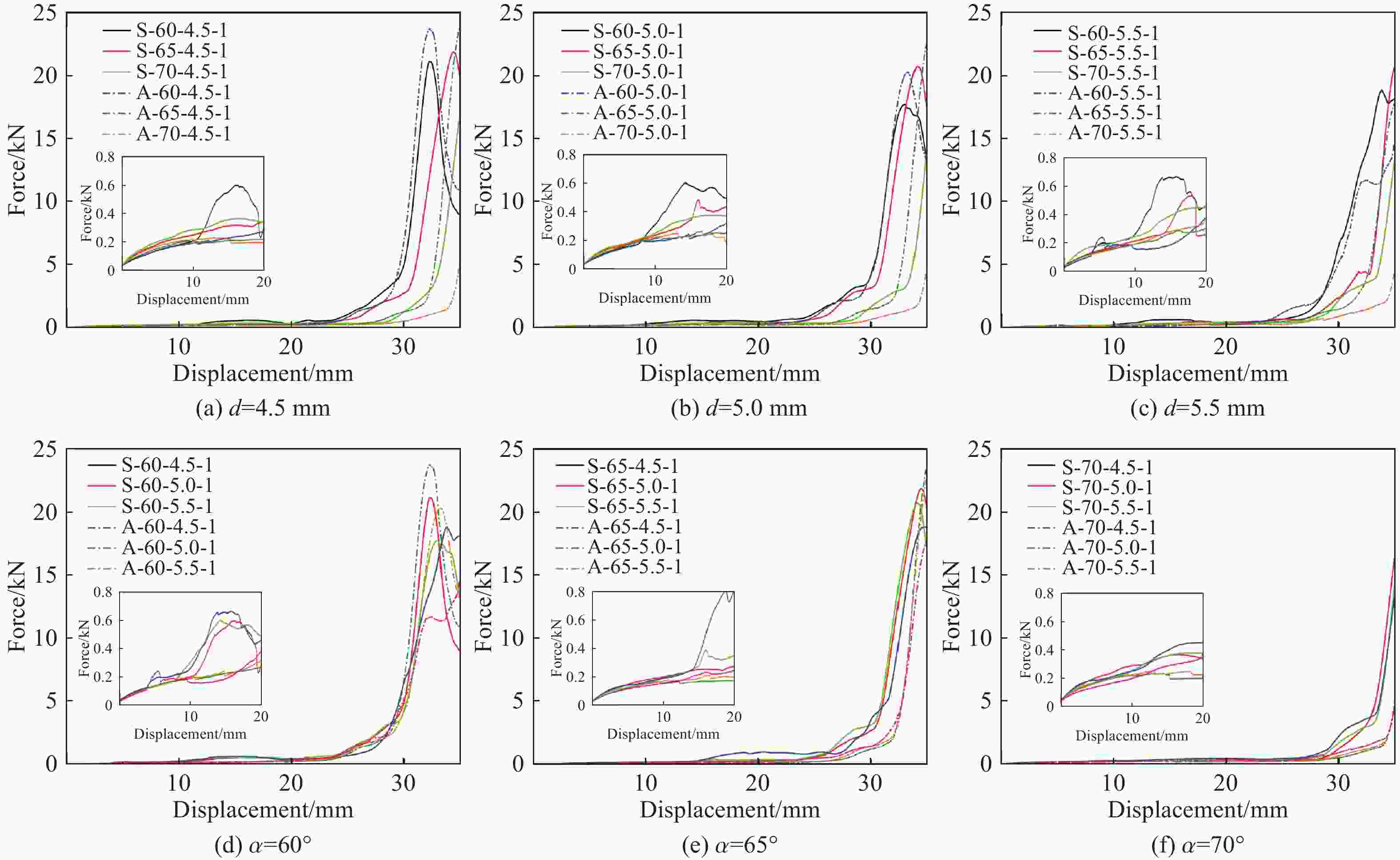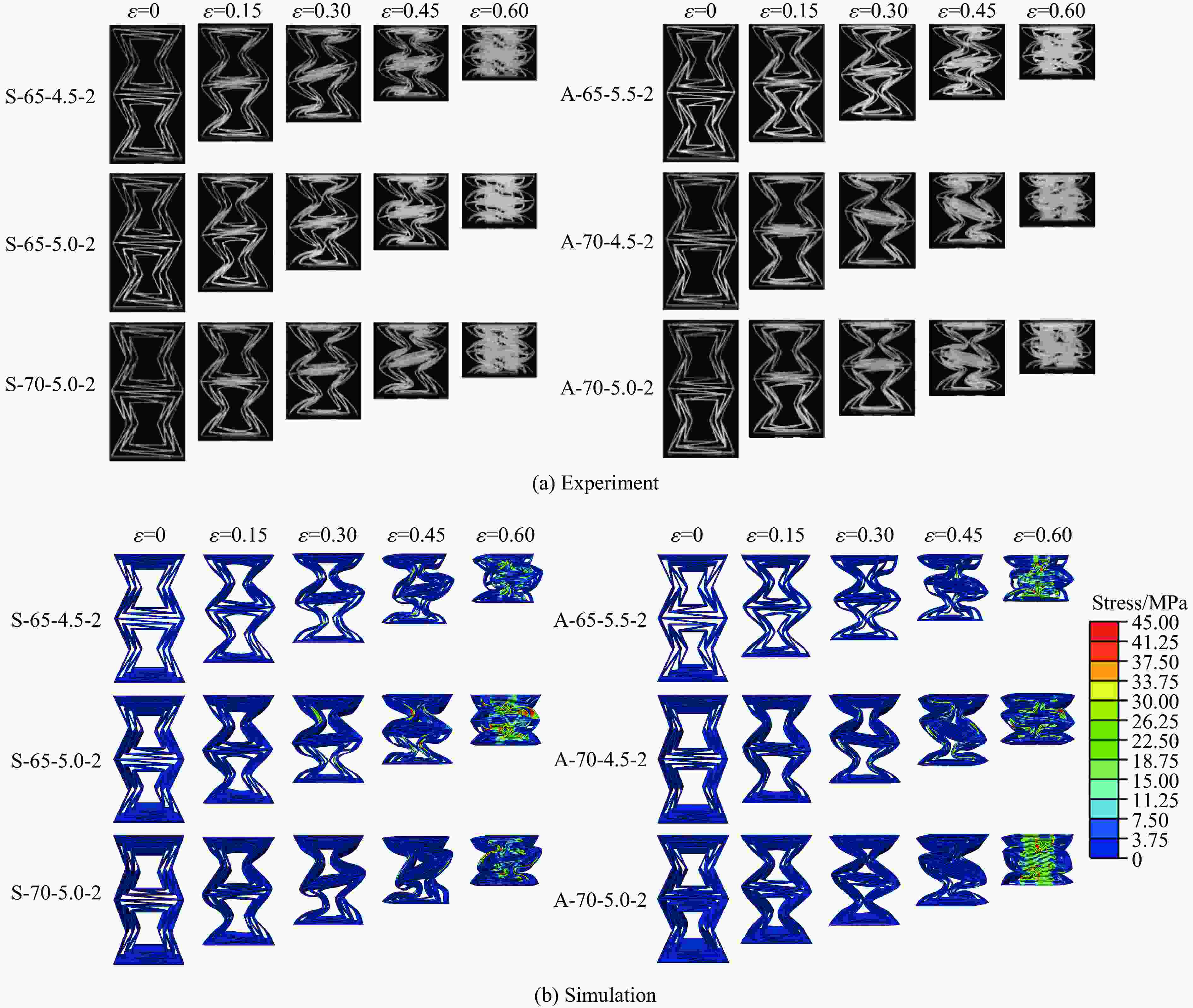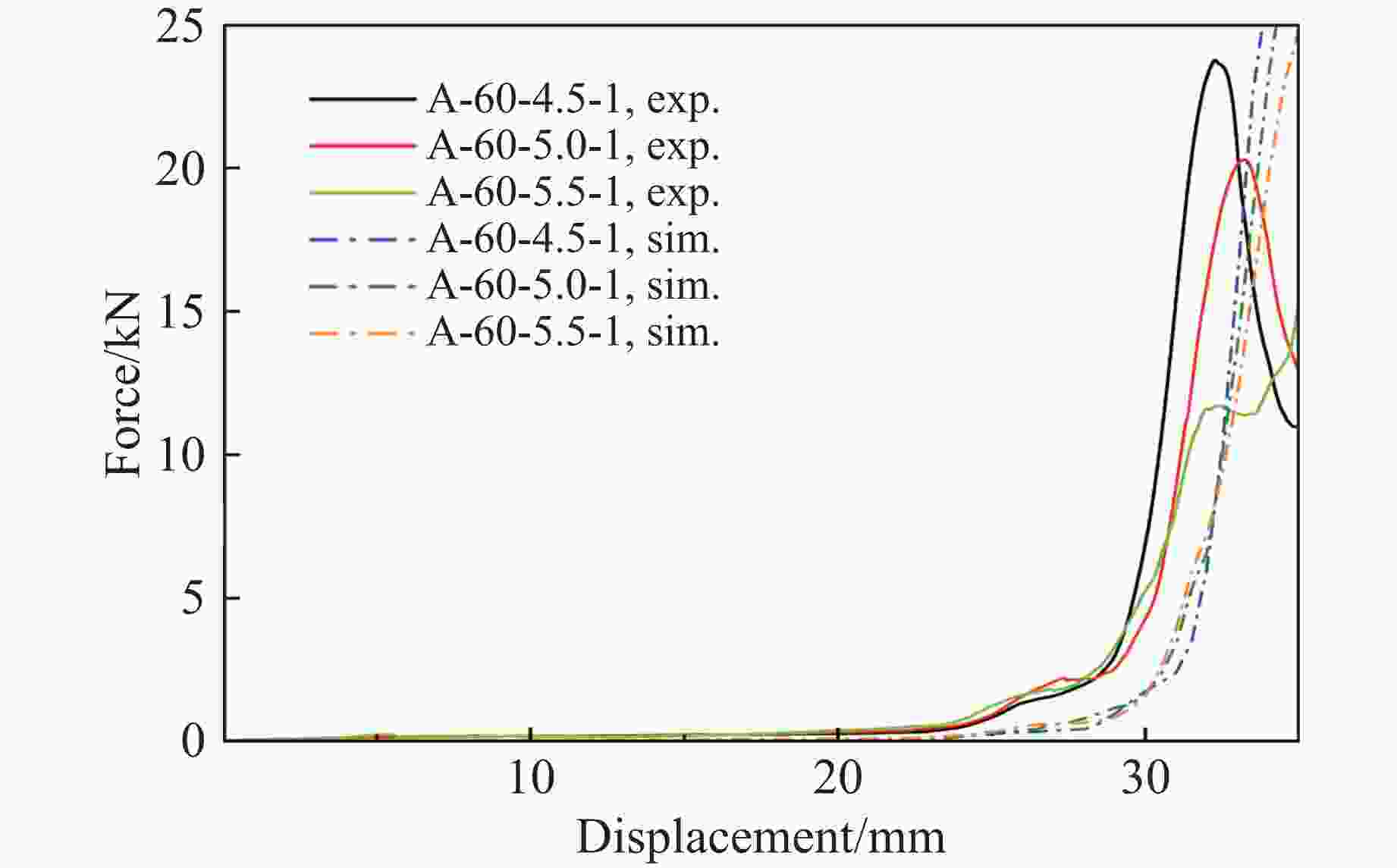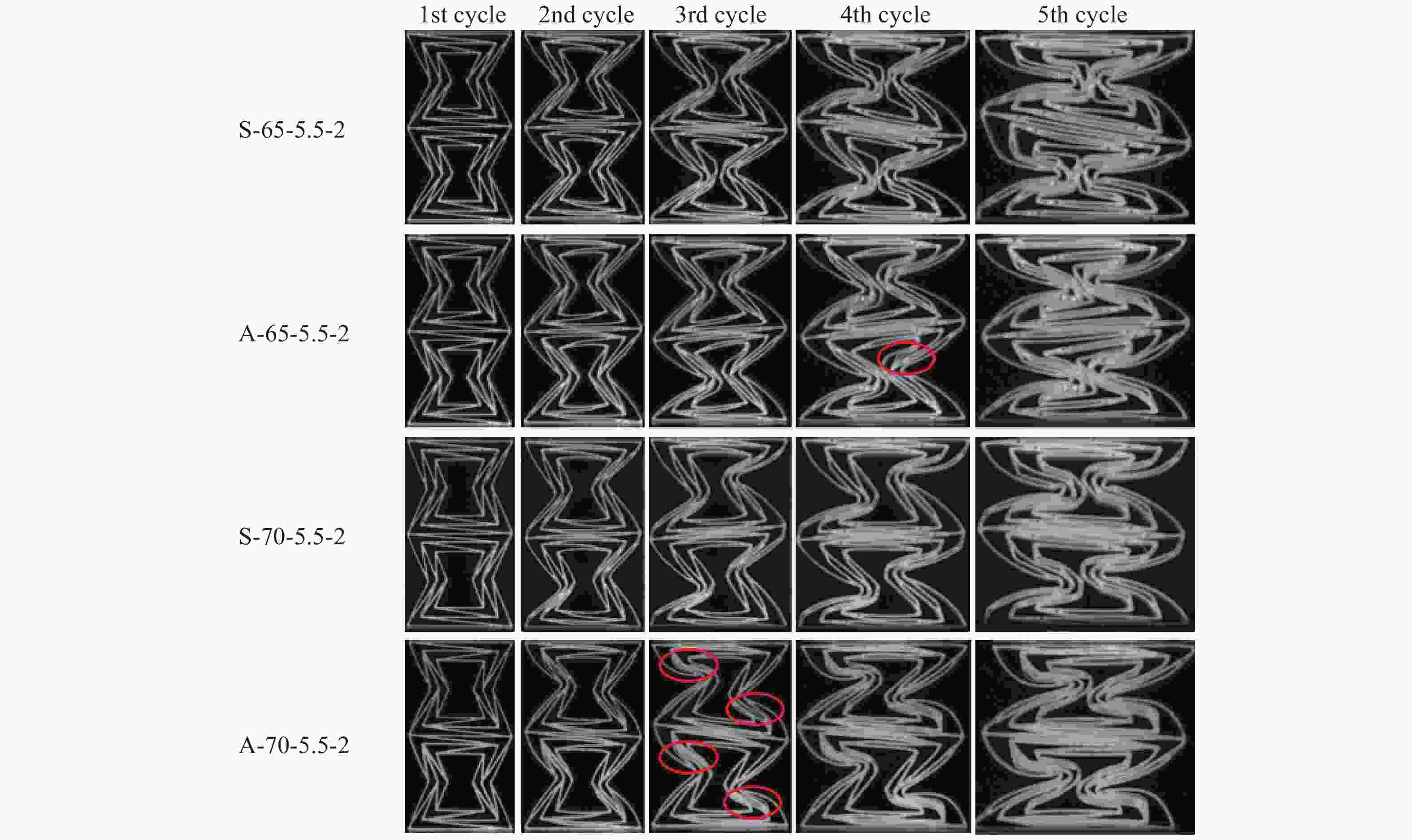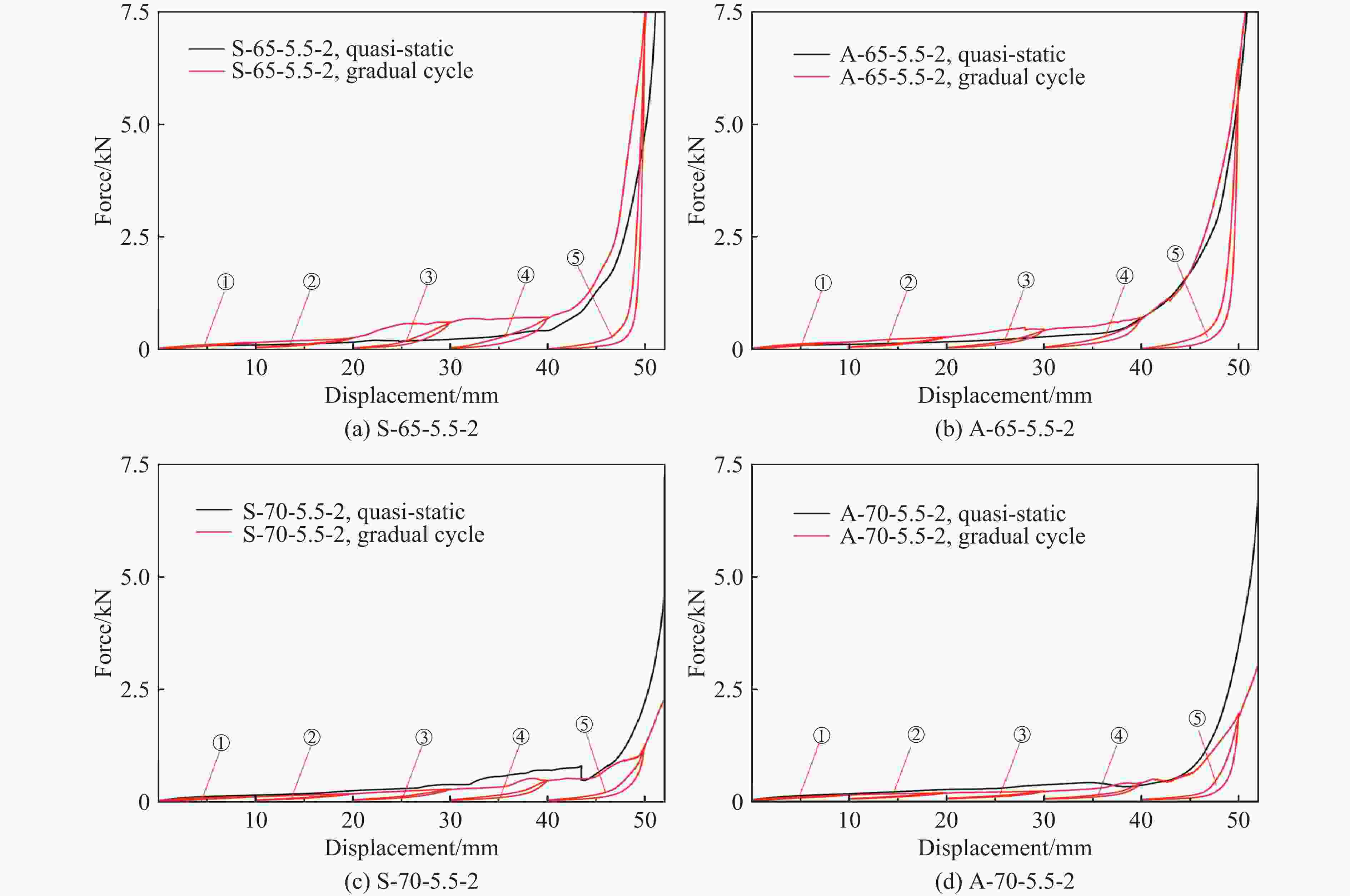Mechanical Behavior Analysis of Porous Nested Structures with Negative Poisson’s Ratio
-
摘要: 采用准静态单轴压缩实验、循环压缩实验和有限元数值模拟,对不同角度、间距和连接方式的多层嵌套内凹六边形单胞结构及其串联结构的变形行为和吸能特性进行分析。结果表明:多层嵌套结构多发生剪切变形,应力小且多集中在斜杆连接处;角度更大、间距更小的交替方式连接的单胞结构拥有更长的平台期;负泊松比单胞结构且角度为65°的试件吸能表现更优异,且同向连接以及间距增大有助于吸能的提升;角度和间距对串联结构平台期的影响与单胞结构相同,连接方式的影响则相反;角度和间距增大、连接方式改变与吸能成正反馈;在循环压缩实验下,试件更易发生分层破坏和塑性断裂,多出现在二次循环后,并伴随应力软化和能量耗散行为,其效果随着循环次数的增加而加重。Abstract: The deformation behavior and energy absorption characteristics of multilayer nested auxetic hexagonal single-cell structures and tandem configurations with different angles, spacing and connection modes were analyzed through quasi-static uniaxial compression experiments, cyclic compression experiments and finite element simulations. The results show that the multilayer nested structure exhibits predominant shear deformation with localized stress concentration at diagonal bar connections, demonstrating lower stress magnitude distribution. The single-cell structures featuring alternating connections with larger angle and reduced spacing exhibit extended plateau phase duration. The specimen with α=65° achieves better energy absorption, where the isotropic connection and increasing spacing enhance the energy absorption capacity. The angle and spacing present analogous effects on the plateau period of both tandem and single-cell structures, while the connection mode demonstrate contrasting influences. Meanwhile, the energy absorption is positively correlated with increased angles and spacing, as well as the variation of the connection mode. Cyclic compression testing induces progressive delamination and plastic fracture in the specimen, predominantly initiating from the second cycle onward, accompanied by stress softening and energy dissipation behaviors that intensify with cycle repetition.
-
表 1 负泊松比单胞结构的吸能指标
Table 1. Energy absorption of negative Poisson’s ratio single-cell structure
Model Ea/J Esa/(J·g−1) Model Ea/J Esa/(J·g−1) Model Ea/J Esa/(J·g−1) S-60-4.5-1 17.236 0.827 S-65-4.5-1 18.475 0.847 S-70-4.5-1 11.009 0.500 S-60-5.0-1 18.972 0.930 S-65-5.0-1 21.508 1.003 S-70-5.0-1 14.852 0.691 S-60-5.5-1 19.896 0.997 S-65-5.5-1 23.880 1.137 S-70-5.5-1 17.913 0.837 A-60-4.5-1 12.307 0.597 A-65-4.5-1 10.931 0.513 A-70-4.5-1 10.222 0.475 A-60-5.0-1 13.571 0.669 A-65-5.0-1 12.577 0.600 A-70-5.0-1 11.253 0.533 A-60-5.5-1 14.407 0.726 A-65-5.5-1 14.867 0.722 A-70-5.5-1 14.256 0.685 表 2 负泊松比串联结构的吸能指标
Table 2. Energy absorption of negative Poisson’s ratio tandem structure
Model Ea/J Esa/(J·g−1) Model Ea/J Esa/(J·g−1) S-65-4.5-1 0.976 0.032 S-70-4.5-1 1.303 0.043 S-65-5.0-1 1.092 0.036 S-70-5.0-1 1.338 0.044 S-65-5.5-1 1.120 0.038 S-70-5.5-1 1.388 0.047 A-65-4.5-1 1.038 0.033 A-70-4.5-1 1.274 0.041 A-65-5.0-1 1.194 0.039 A-70-5.0-1 1.377 0.045 A-65-5.5-1 1.422 0.047 A-70-5.5-1 1.449 0.049 -
[1] 董凯, 沈振, 刘现荣, 等. 轻钢龙骨-铝蜂窝复合墙板对钢框架结构抗震性能影响研究 [J]. 建筑结构, 2024, 54(23): 50–57. doi: 10.19701/j.jzjg.LS220268DONG K, SHEN Z, LIU X R, et al. Study on influence of light steel keel-aluminum honeycomb composite wallboard on seismic performance of steel frame structure [J]. Building Structure, 2024, 54(23): 50–57. doi: 10.19701/j.jzjg.LS220268 [2] 罗耿, 柴成鹏, 祝召飞, 等. 3D打印梯度随机蜂窝夹芯结构耐撞性研究与多目标优化设计 [J]. 汽车工程, 2024, 46(11): 2110–2121. doi: 10.19562/j.chinasae.qcgc.2024.11.017LUO G, CHAI C P, ZHU Z F, et al. Research on the crashworthiness of 3D printing gradient random honeycomb sandwich structure and multi-objective optimization design [J]. Automotive Engineering, 2024, 46(11): 2110–2121. doi: 10.19562/j.chinasae.qcgc.2024.11.017 [3] 马昊, 陈美多, 袁良柱, 等. 中等应变率下纸蜂窝结构的力学性能研究 [J]. 高压物理学报, 2024, 38(4): 044104. doi: 10.11858/gywlxb.20240701MA H, CHEN M D, YUAN L Z, et al. Study on mechanical properties of paper honeycomb structure at medium strain rates [J]. Chinese Journal of High Pressure Physics, 2024, 38(4): 044104. doi: 10.11858/gywlxb.20240701 [4] 沈鲁豫, 温垚珂, 董方栋, 等. TPU材料负泊松比结构缓冲性能研究 [J]. 兵器装备工程学报, 2024, 45(2): 291–299. doi: 10.11809/bqzbgcxb2024.02.038SHEN L Y, WEN Y K, DONG F D, et al. Study on buffer performance of TPU material with negative Poisson’s ratio structure [J]. Journal of Ordnance Equipment Engineering, 2024, 45(2): 291–299. doi: 10.11809/bqzbgcxb2024.02.038 [5] OU H F, HU L L, WANG Y B, et al. High-efficient and reusable impact mitigation metamaterial based on compression-torsion coupling mechanism [J]. Journal of the Mechanics and Physics of Solids, 2024, 186: 105594. doi: 10.1016/j.jmps.2024.105594 [6] LI P Q, WANG K F, WANG B L. Nonlinear vibration of the sandwich beam with auxetic honeycomb core under thermal shock [J]. Thin-Walled Structures, 2024, 196: 111479. doi: 10.1016/j.tws.2023.111479 [7] CHEN Y W, YANG K, WANG Y B, et al. Design and mechanical properties analysis of structures with shape memory negative Poisson’s ratio [J]. Mechanics of Solids, 2024, 59(4): 2509–2534. doi: 10.1134/S0025654424604476 [8] 陈翔, 熊浪, 付福康, 等. 负泊松比型镍钛合金血管支架结构设计及其在血管中的支撑性能研究 [J]. 稀有金属材料与工程, 2024, 53(11): 3136–3148. doi: 10.12442/j.issn.1002-185X.20230542CHEN X, XIONG L, FU F K, et al. Structural design of negative Poisson’s ratio NiTinol stent and its performance in vascular support [J]. Rare Metal Materials and Engineering, 2024, 53(11): 3136–3148. doi: 10.12442/j.issn.1002-185X.20230542 [9] 庄晟逸, 李成伟, 向文超, 等. 负泊松比结构的改进设计及其在航空航天中的应用 [J]. 化工学报, 2024, 75(11): 3951–3972. doi: 10.11949/0438-1157.20240878ZHUANG S Y, LI C W, XIANG W C, et al. Improved designs of negative Poisson’s ratio structure and their applications in aerospace engineering [J]. CIESC Journal, 2024, 75(11): 3951–3972. doi: 10.11949/0438-1157.20240878 [10] 丁海滨, 黄年勇, 徐长节, 等. 负泊松比局域共振地震超材料减隔振特性研究 [J]. 振动与冲击, 2024, 43(15): 179–188, 208. doi: 10.13465/j.cnki.jvs.2024.15.021DING H B, HUANG N Y, XU C J, et al. Seismic reduction and isolation characteristics of negative Poisson ratio local resonance seismic metamaterial [J]. Journal of Vibration and Shock, 2024, 43(15): 179–188, 208. doi: 10.13465/j.cnki.jvs.2024.15.021 [11] 李锐, 李成兵, 李仁富, 等. 内嵌负泊松比型耦合蜂窝结构的共面冲击响应 [J]. 塑性工程学报, 2024, 31(5): 224–232. doi: 10.3969/j.issn.1007-2012.2024.05.026LI R, LI C B, LI R F, et al. In-plane impact response of coupled honeycomb structure with embedded negative Poisson’s ratio [J]. Journal of Plasticity Engineering, 2024, 31(5): 224–232. doi: 10.3969/j.issn.1007-2012.2024.05.026 [12] 孔维凡, 付涛. 负泊松比内凹六边形蜂窝夹层板的吸声性能 [J]. 复合材料学报, 2024, 41(4): 2157–2166. doi: 10.13801/j.cnki.fhclxb.20231024.003KONG W F, FU T. Sound absorption performance of concave hexagonal honeycomb sandwich panels with negative Poisson’s ratio [J]. Acta Materiae Compositae Sinica, 2024, 41(4): 2157–2166. doi: 10.13801/j.cnki.fhclxb.20231024.003 [13] 丛苏婷, 周一一, 陈联盟. 凹六边形负泊松比蜂窝结构及其静动力学性能研究综述 [J]. 空间结构, 2024, 30(2): 21–31. doi: 10.13849/j.issn.1006-6578.2024.02.021CONG S T, ZHOU Y Y, CHEN L M. Review on the study of concave hexagonal negative Poisson’s ratio honeycomb structures and their static and dynamic performance [J]. Spatial Structures, 2024, 30(2): 21–31. doi: 10.13849/j.issn.1006-6578.2024.02.021 [14] WANG X X, FU T. Improvement of broadband low-frequency sound insulation of sandwich plates with negative Poisson’s ratio butterfly-shaped auxetic cellular [J]. Engineering Analysis with Boundary Elements, 2024, 166: 105852. doi: 10.1016/J.ENGANABOUND.2024.105852 [15] 贺锋, 梁一鸣, 李季, 等. 异型陶瓷负泊松比复合结构的防弹防爆性能数值模拟研究 [J]. 安全与环境学报, 2024, 24(8): 2919–2928. doi: 10.13637/j.issn.1009-6094.2023.2075HE F, LIANG Y M, LI J, et al. Numerical simulation study on ballistic and blast resistance of heterotypic ceramic negative Poisson’s ratio composite structures [J]. Journal of Safety and Environment, 2024, 24(8): 2919–2928. doi: 10.13637/j.issn.1009-6094.2023.2075 [16] 胡启华, 聂瑞, 张超, 等. 可调负泊松比蜂窝结构在变面积机翼上的应用 [J]. 哈尔滨工业大学学报, 2024, 56(8): 24–33. doi: 10.11918/202307016HU Q H, NIE R, ZHANG C, et al. Application of adjustable negative Poisson’s ratio honeycomb structure on variable-area wing [J]. Journal of Harbin Institute of Technology, 2024, 56(8): 24–33. doi: 10.11918/202307016 [17] 王帅, 陈卓, 李佳璐, 等. 空间交叉内凹蜂窝结构力学特性研究 [J]. 机械强度, 2024, 46(6): 1419–1432. doi: 10.16579/j.issn.1001.9669.2024.06.019WANG S, CHEN Z, LI J L, et al. Study on mechanical properties of spatial intersection concave honeycomb structure [J]. Journal of Mechanical Strength, 2024, 46(6): 1419–1432. doi: 10.16579/j.issn.1001.9669.2024.06.019 [18] 王玮婧, 张伟明, 郭孟甫, 等. 内凹-星型三维负泊松比结构设计及冲击吸能特性 [J]. 振动与冲击, 2024, 43(6): 75–83. doi: 10.13465/j.cnki.jvs.2024.06.008WANG W J, ZHANG W M, GUO M F, et al. Design and impact energy absorption characteristics of concave-star three dimensional negative Poisson’s ratio structures [J]. Journal of Vibration and Shock, 2024, 43(6): 75–83. doi: 10.13465/j.cnki.jvs.2024.06.008 [19] 黄巧巧, 邓庆田, 李新波, 等. 模块化多孔结构的变形模式及吸能特性 [J]. 高压物理学报, 2024, 38(6): 064106. doi: 10.11858/gywlxb.20240737HUANG Q Q, DENG Q T, LI X B, et al. Deformation mode and energy absorption of modularized cellular structures [J]. Chinese Journal of High Pressure Physics, 2024, 38(6): 064106. doi: 10.11858/gywlxb.20240737 [20] 杨延新, 宋玉超, 池常宽, 等. 内凹型负泊松比结构的静载与隔振分析 [J]. 噪声与振动控制, 2025, 45(1): 287–293. doi: 10.3969/j.issn.1006-1355.2025.01.045YANG Y X, SONG Y C, CHI C K, et al. Static load and vibration isolation analysis of internal concave structures with negative Poisson’s ratio [J]. Noise and Vibration Control, 2025, 45(1): 287–293. doi: 10.3969/j.issn.1006-1355.2025.01.045 -







 下载:
下载:
